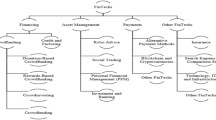Abstract
This paper explores the behavior of the banking industry in the new business environment that arose after the subprime crisis. The main hypothesis is that there are two major types of banking institutions: conventional banks and ethical banks. Each has a distinct business model. To test how they have reacted to the new environment, factor analysis techniques have been used. The main findings are twofold. Firstly, the new financial context has indeed caused the behavior of mainstream banks to change. Within this group, one can further distinguish between those that have tried to anticipate the changes by adopting a more responsible financial attitude and those that have merely modified their banking practice to comply with the new regulatory framework. Secondly, there are the so-called ethical banks. Interestingly, their behavior has scarcely been altered by the new financial context. The main conclusion is that the different response of both types of banks reflects the existence of a distinct business model.

Similar content being viewed by others
References
Altunbas, Y., & Marqués, D. (2008). Mergers and acquisitions and bank performance in Europe: The role of strategic similarities. Journal of Economics and Business, 60(3), 204–222.
Balling, M., Lierman, F., Van den Spiegel, F., Ayadi, R., & Llewellyn, D. T. (Eds.). (2012). New paradigms in banking, financial markets and regulation?. Vienna: Larcier.
Bank of International Settlements (BIS). (2010a). Basel III: A global regulatory framework for more resilient banks and banking systems. http://www.bis.org/publ/bcbs189_dec2010.htm. Accessed Dec 2010.
Bank of International Settlements (BIS). (2010b). Assessing the macroeconomic impact of the transition to stronger capital and liquidity requirements. http://www.bis.org/publ/othp10.htm. Accessed Aug 2010.
Bank of International Settlements (BIS). (2010c). Basel III: international framework for liquidity risk measurement, standards and monitoring. http://www.bis.org/publ/bcbs165.htm. Accessed Dec 2009.
Bank of International Settlements (BIS). (2010d). Results of the comprehensive quantitative impact study. http://www.bis.org/publ/bcbs186.pdf. Accessed Dec 2010.
Berger, A. N., Demsetz, R. S., & Strahan, P. E. (1999). The consolidation of the financial services industry: Causes, consequences, and implications for the future. Journal of Banking and Finance, 23(2), 135–194.
Brammer, S., Jackson, G., & Matten, D. (2012). Corporate social responsibility and institutional theory: New perspectives on private governance. Socio-Economic Review, 10, 3–28.
Cattell, R. B. (1978). The scientific use of factor analysis. New York: Plenu.
Cowton, C. J., & Thompson, P. (2001). Financing the social economy: A case study of Triodos Bank. International Journal of Nonprofit and Voluntary Sector Marketing, 6(2), 145–155.
Dermine, J. (2013). Bank regulations after the global financial crisis: Good intentions and unintended evil. European Financial Management, 19(4), 658–674.
Financial Services Authority (FSA). (2009). The turner review: A regulatory response to the global banking crisis. http://www.fsa.gov.uk/pubs/other/turner_review.pdf.
Giddings, B., Hopwood, B., & O’Brien, G. (2002). Environment, economy and society: Fitting them together into sustainable development. Sustainable Development, 10(4), 187–196.
Giustiniani, A., & Thornton, J. (2011). Post-crisis financial reform: where do we stand? Journal of Financial Regulation and Compliance, 19(4), 323–336.
Hotelling, H. (1933). Analysis of a complex of statistical variables into principal components. Journal of Educational Psychology, 24, 498–520.
Jeucken, M. (2001). Sustainable finance and banking: the financial sector and the future of the planet. London: Earthscan Publication Ltd.
Jolliffe, I. T. (2010). Principal component analysis (2nd ed.). New York): Springer.
Leire, S. J., Retoloza, J. L., & Gutierrez, J. (2011). Are ethical banks different? A comparative analysis using the radical affinity index. Journal of Business Ethics, 100(1), 151–173.
Masciandaro, D., Pansini, R., & Quintyn, M. (2011). The economic crisis: Did financial supervision matter? IMF Working Paper, WP 11/261.
Mulaik, S. A. (1972). The foundations of factor analysis. New York: McGraw-Hill.
Nilsen, H. (2010). CSR in Banking: The Pursuit toward Repairing Legitimacy and Reputation: A Case Study of Den Norske Bank and Danske Bank (Master Thesis, Copenhagen Business School, Copenhagen).
Paulet, E., Parnaudeau, M., Abdessemed, T. (2013). European banks’ behavior facing the contemporary subprime crisis: Towards a typology. 3rd International conference of the financial engineering and Banking society, Paris ESCP Europe Campus.
Relano, F. (2008). From sustainable finance to ethical banking. Transformations in Business and Economics, 7(3), 123–131.
Roubini, N. (2008). Ten Fundamental Issues in Reforming Financial Regulation and Supervision in a World of Financial Innovation and Globalization, RGE Monitor http://media.rgemonitor.com/papers/0/Nouriel-RegulationSupervisionMarch08.pdf.
Royce, J. R. (1963). Factors as theoretical constructs. In D. N. Jackson & S. Messick (Eds.), Problems in human assessment. New York: McGraw-Hill.
Russell, J., & Cohn, R. (2012). Principal component analysis. Key Biscayne: Bookvika Publishing.
Saeed, K. (2004). Designing an environmental mitigation banking institutions for linking the size of economic activity to environmental capacity. Journal of Economic Issues, 38(4), 909–937.
Simpson, W. G., & Kohers, T. (2002). The link between corporate social and financial performance: Evidence from the banking industry. Journal of Business Ethics, 35(2), 97–109.
Soana, M. G. (2011). The relationship between corporate social performance and corporate financial performance in the banking industry. Journal of Business Ethics, 104(1), 133–148.
Author information
Authors and Affiliations
Corresponding author
Rights and permissions
About this article
Cite this article
Paulet, E., Parnaudeau, M. & Relano, F. Banking with Ethics: Strategic Moves and Structural Changes of the Banking Industry in the Aftermath of the Subprime Mortgage Crisis. J Bus Ethics 131, 199–207 (2015). https://doi.org/10.1007/s10551-014-2274-9
Received:
Accepted:
Published:
Issue Date:
DOI: https://doi.org/10.1007/s10551-014-2274-9




